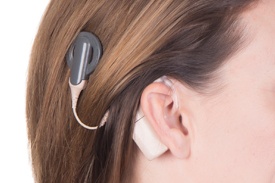 A cochlear implant is a small, surgically implanted electronic device that can help to provide access to sound to people with severe to profound hearing loss and those who cannot hear or understand speech with hearing aids. While hearing aids make sound louder, cochlear implants directly stimulate the nerve fibers in the inner ear (cochlea). An implant does not create normal hearing; instead, under the appropriate conditions, it can give a deaf individual useful auditory understanding of speech and environmental sounds.
A cochlear implant is a small, surgically implanted electronic device that can help to provide access to sound to people with severe to profound hearing loss and those who cannot hear or understand speech with hearing aids. While hearing aids make sound louder, cochlear implants directly stimulate the nerve fibers in the inner ear (cochlea). An implant does not create normal hearing; instead, under the appropriate conditions, it can give a deaf individual useful auditory understanding of speech and environmental sounds.
A cochlear implant involves a surgical procedure. The decision to receive an implant should involve discussions with a medical team and an experienced surgeon. The surgery is performed by an otolaryngologist (ear, nose and throat specialist.) It may be done as an outpatient procedure or it may require a hospital stay. The surgical procedure usually takes between 2-3 hours.
How Does a Cochlear Implant Work?
A cochlear implant consists of surgically implanted and externally worn components. The surgically implanted components include a receiver and an electrode array. The receiver is the part of the device that is surgically implanted behind the ear. It contains a magnet. The receiver, about the size of a quarter, receives the signals from the speech processor and converts them into electrical impulses. A very small wire leads from the receiver to an electrode array that is placed in the cochlea in the inner ear. It collects the impulses from the receiver and sends them to the brain.
The externally worn (not implanted) components include a microphone, a speech processor, and a transmitting coil. A small headpiece is worn behind the ear and contains the microphone that picks up sound form the environment. The speech processor, which selects and arranges the sounds picked up by the microphone, is either worn on the body or behind the ear. The transmitting coil, a small disk, also about the size of a quarter, adheres to the skin behind the ear, connected to the implanted magnet (receiver). It is connected to the microphone by a small cable.









